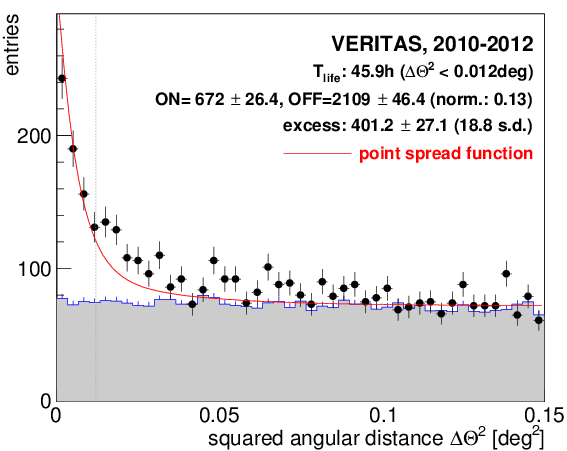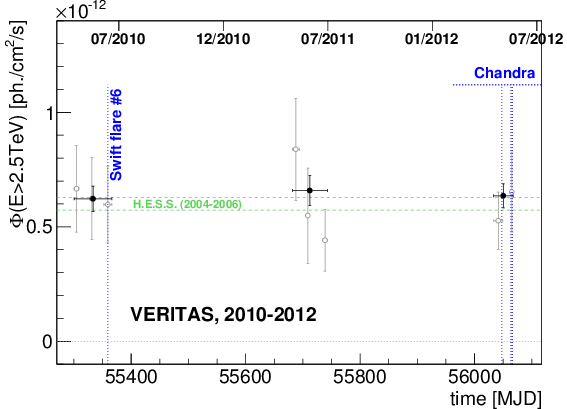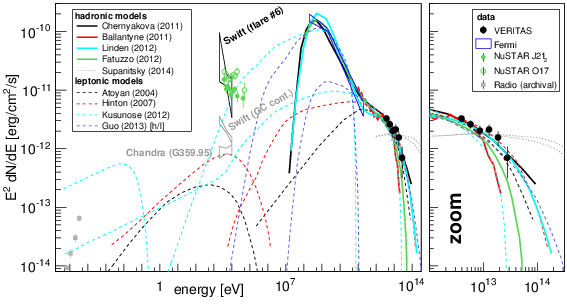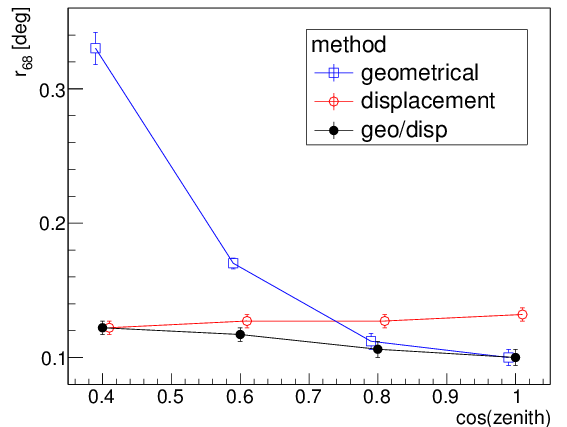The Galactic center is an interesting region for high-energy (0.1-100 GeV) and very-high-energy (E > 100 GeV) gamma-ray observations. Potential sources of GeV/TeV gamma-ray emission have been suggested, e.g., the accretion of matter onto the supermassive black hole, cosmic rays from a nearby supernova remnant (e.g. SgrA East), particle acceleration in a plerion, or the annihilation of dark matter particles. The Galactic center has been detected by EGRET and by Fermi/LAT in the MeV/GeV energy band. At TeV energies, the Galactic center was detected with moderate significance by the CANGAROO and Whipple 10 m telescopes and with high significance by H.E.S.S., MAGIC, and VERITAS. We present the results from three years of VERITAS observations conducted at large zenith angles resulting in a detection of the Galactic center on the level of 18 standard deviations at energies above ~2.5 TeV. The energy spectrum is derived and is found to be compatible with hadronic, leptonic and hybrid emission models discussed in the literature. Future, more detailed measurements of the high-energy cutoff and better constraints on the high-energy flux variability will help to refine and/or disentangle the individual models.
Figure 1: VERITAS angular resolution (68% containment radius r68) as a function of cos(zenith) derived from Monte Carlo simulations with the requirement of at least three images involved in the shower reconstruction. The geometrical algorithm performs well for zenith angles < 40 deg (cos(z) > 0.8) but gets worse for large zenith angles. At zenith angles of 65 deg, the displacement method outperforms the geometrical algorithm by a factor of more than 2. A weighted combination of both algorithms (geometrical/displacement, see
text) gives an almost flat angular resolution.

Figure 2: The data points show the angular distribution of excess events from 6.5 hrs of Crab Nebula observations taken at zenith angles z > 55 deg. The showers were reconstructed with the combined geometrical/displacement method. The solid red line represents the angular distribution of Monte Carlo events (same reconstruction method) covering the same zenith angle range as the data. The dashed blue line shows the distribution of Monte Carlo events which were reconstructed with the standard geometrical algorithm. The inlay shows the smoothed excess sky map of the Crab Nebula data (geometrical/displacement method).

Figure 3: Distribution of the squared angular distance ΔΘ2 between the reconstructed shower direction and the nominal position of the Galactic center (data points). The distribution is also shown with respect to the events from the reflected OFF regions (shaded area) that are used to determine the background. The red curve represents the point-spread function determined from Monte-Carlo simulations for the corresponding zenith angle interval, normalized to the measured excess determined from the ΔΘ2 < 0.012 deg2 regime (vertical dotted line).

Figure 4: VERITAS sky map of the Galactic center region (smoothed excess signi ficances, ring background model). The VERITAS centroid position is indicated by the cross (statistical and systematic errors) and the Sgr A* radio position is indicated by the 'x'. The solid black contour lines indicate the Galactic center and the supernova remnant G0.9+0.1 as seen by H.E.S.S. (Aharonian et al. 2004). The white dashed contour lines indicate the H.E.S.S. diffuse emission along the Galactic plane and from HESS J1745-303 (Aharonian et al. 2006a). The position of HESS J1741-302 is indicated by the labeled circle. The green solid ellipses indicate the positions of the MeV/GeV sources and their 95% position errors taken from the second Fermi/LAT catalog (Nolan et al. 2012). The green dash-dotted contour lines indicate the 1 - 100 GeV diffuse emission (after subtracting point-sources, Galactic, and extragalactic backgrounds) as measured by Fermi/LAT (Yusef-Zadeh et al. 2013). The instruments' point spread functions (68% containment radius) of VERITAS and Fermi/LAT (1 - 100 GeV, calculated for the 2FGL log parabola spectrum of the source coincident with SgrA*) are indicated in the upper left corner.

Figure 5: VERITAS energy spectra shown for LZA observations of the Crab nebula and the Galactic center (statistical errors only). Also indicated are the fi t results of the spectra measured by Whipple (dotted bow tie, Kosack et al. (2005)), H.E.S.S. (solid bow ties, Aharonian et al. (2006b, 2009)), and MAGIC (dashed bow ties, Albert et al. (2008, 2006)).

Figure 6: Integral flux above 2.5 TeV from the direction of the Galactic center on a month-by-month basis (open points), as well as the yearly averages (solid points). The time of the X-ray flare #6 detected by Swift (Degenaar et al. 2013) is indicated. The period of X-ray Chandra observations of Sgr A* (Neilsen et al. 2013) is shown as the dotted horizontal line. VERITAS synchronized four observations with the Chandra pointings (same day, vertical lines). The dashed horizontal lines indicate the statistical error range of the 2004-2006 average TeV Υ-ray flux which was derived by integrating the H.E.S.S. spectrum shown in Fig. 5 for E > 2.5 TeV.

Figure 7: Left: VERITAS spectral energy distribution of the Galactic center point-source compared to hadronic and leptonic emission models as discussed in the text. The Fermi/LAT bow tie is taken from Chernyakova et al. (2011). The multi-wavelength data points shown are archival radio (Davies et al. 1976), X-ray flares observed by Swift (Degenaar et al. 2013) and NuSTAR (Barriere et al. 2014), as well as flux measurements from Chandra (Wang et al. 2006). Right: Zoomed version of the TeV regime.








